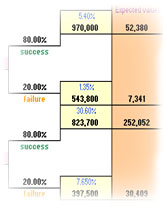|
 |
Methods
SG Systems can perform expected value analysis with real
options modeling during all
aspects of early-stage, mid-stage, and late-stage product
development. Decision
tree modeling is a standard method for determining expected
value from a single product or an array of products and can
take into account the abandonment option, option to switch
inputs or outputs, option to delay, or option to grow [real options].
Also, simple NPV weighting based on expected probability of
positive outcome is used. More often than not, both
techniques are used as a sanity check against each other.
 The decision tree model is typically a simple yes / no
Boolean equation which either moves the product along their
path to becoming a marketed product ["yes" branch] or shunts
the product off the valuation model ["no" branch] onto a
negative branch. The negative branch is also referred
to as the abandonment option where 'staying the course' is
obviously the wrong choice. The decision tree model will return
an expected NPV, positive or negative, for the project in
either case because you will have spent money to get the
product to whatever its end point is, a market product or
not. Also, the transparent decision tree model allows
examination of all nodal points and can highlight some
important, perhaps overlooked information. The decision tree model is typically a simple yes / no
Boolean equation which either moves the product along their
path to becoming a marketed product ["yes" branch] or shunts
the product off the valuation model ["no" branch] onto a
negative branch. The negative branch is also referred
to as the abandonment option where 'staying the course' is
obviously the wrong choice. The decision tree model will return
an expected NPV, positive or negative, for the project in
either case because you will have spent money to get the
product to whatever its end point is, a market product or
not. Also, the transparent decision tree model allows
examination of all nodal points and can highlight some
important, perhaps overlooked information.
Expected value analysis / real options modeling is an excellent tool for determining
and evaluating overall company risk and can even impact the
firm's cost of capital.
For more details see
Case
Study: Expected Value Analysis / Real Options.
|

